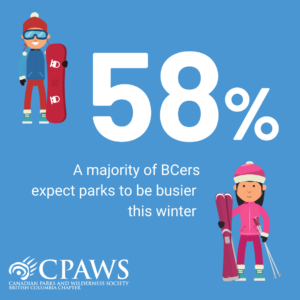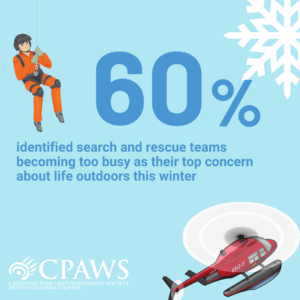
3 Ways BC is Part of the Solution #ForNature
Biodiversity Day 2021
Biodiversity is the rich variety of life on Earth, from genes to wild ecosystems, and it can encompass all nature and culture that sustains life.
The world is facing a biodiversity crisis. Decades of climate change and unchecked industrial development pushes nature’s limits. British Columbia is on the frontlines of the fight to protect our remaining wild land and seascapes, and the plants and animals that depend on them.
We have a choice: take bold action to defend against the decline of species, or watch as iconic animals like caribou and orca vanish forever. With your help, CPAWS-BC is helping governments make the best decision.
Biodiversity Day 2021 celebrates being part of the solution #ForNature. From nature-based solutions to climate, health issues, food and water security, and sustainable livelihoods, biodiversity is the foundation upon which we can build back better.
CPAWS-BC has a plan to stem the nature emergency and ensure healthy ecosystems now and forever. When nature thrives, so do we.
Here’s three ways BC is part of the solution #ForNature.
Indigenous-led Conservation
Indigenous-managed lands and water play a critical role in helping species survive. Research shows the total numbers of birds, plants, fish and wildlife were the highest on lands managed or co-managed by Indigenous communities. Our Indigenous partners help incorporate Indigenous Knowledge into every aspect of our work. On the path to Canada’s goal of protecting 25% of lands, freshwater and ocean by 2025, provincial and federal governments commit to helping establish Indigenous Protected and Conserved Areas (IPCAs).
We all truly need to work together. We are in a deep biodiversity crisis, we’re in a water crisis, we’re in a climate crisis. We really need to rely on Indigenous teachings in order to help protect these beautiful lands and waters.
– Annita Mcphee, Executive Director (Read the full interview in The Narwhal)
https://www.facebook.com/watch/?v=291099785971856
Large and Interconnected Protected Areas
Recent studies have found that over half of the world’s wildlife populations have been lost in less than half a century. Protected areas offer a nature-based solution to combat the biodiversity crisis.
Today, about 15.5% of BC’s lands and inland waters are fully protected under legislated protected areas, with 4% falling into the category of Other Effective Area-Based Conservation Measures (OECMs).
BC has a leading role to play to help reach commitments to protecting 25% of Canada’s land and ocean by 2025 and 30% by 2030.
“Expanding protected areas is essential for the future of British Columbia. Healthy ecosystems and intact forests don’t just exist for wildlife. Our communities need protected areas for sustainable livelihoods, human health, cultural values, and to ensure a livable future.” – Jessie Corey, Terrestrial Conservation Manager.
Thanks to our supporters and partners, we’ve made great strides to protect large parks, protected areas and wildlife corridors like Tatshenshini, Muskwa Kechika, Gwaii Haanas (the southern tip of Haida Gwaii), and the Scott Islands.
Let’s keep this momentum going. In April, Canada announced an historic investment for nature that will protect and restore forest, grassland, and wetlands.

Bold investments like these can propel conservation in BC on the path to 25 percent land and water protection by 2025, and 30% by 2030:
- The Deepsea Oasis off the west coast of Vancouver Island will protect unique deep sea ecosystems and cover almost 2.5% of Canada’s ocean.
- Led by Indigenous communities, Canada’s first MPA network along BC’s north and central coasts will protect whales and other migrating ocean animals while also ensuring healthy coastal communities for generations.
- The proposed Dene Kʼéh Kusān protected area in Kaska territory promises to protect an intact wilderness area larger than Vancouver Island.
Safeguarding Species at Risk
BC is home to 1,807 species of animals and plants at risk of extinction. That’s more than any other province or territory in Canada.
Collaboration between First Nations, environmental groups and governments offers a hopeful path forward for better conservation.

- Last year, Saulteau and West Moberly First Nations announced a partnership agreement with BC and Canada to protect and recover caribou in the Peace Region.
- The proposed Southern Strait of Georgia National Marine Conservation Area Reserve will safeguard important feeding waters for the critically endangered Southern Resident killer whales and some 3000 other marine species.
- The new Fish, Wildlife, and Habitat Coalition, wants to see BC re-establish itself as a world leader in fish, wildlife and habitat management.
“We have no time to waste with the rampant global biodiversity crisis and declining wildlife populations across the province. CPAWS-BC is looking forward to working collaboratively with the coalition partners and all levels of government to improve the state of the lands, waters and wildlife across BC.” – Tori Ball, Senior Campaigner.
This Biodiversity Day, join the thousands of BCers defending biodiversity. Sign-up to receive the latest updates, nature news and actions from CPAWS right to your inbox.
Subscribe Donate


